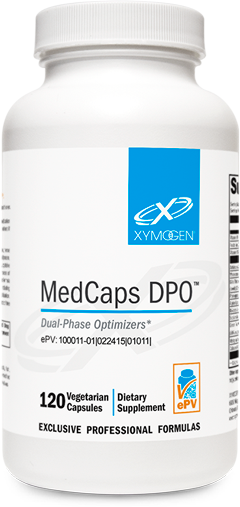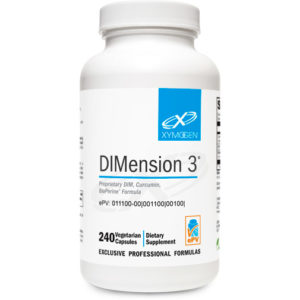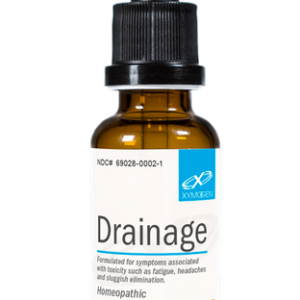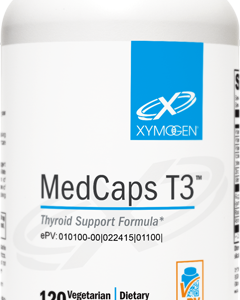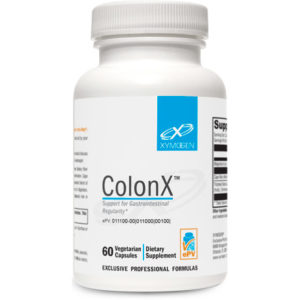Scientific Information/Data
The term “Dual-Phase Optimizers” refers to those substances with the ability to simultaneously influence and “optimize” the activity of certain phase I and phase II detoxification enzyme systems. Optimizers generally upregulate or induce phase II enzymes; however, optimizing phase I enzymes may mean downregulating them, without totally inhibiting them, when they are too high. Dual-phase optimizers may further balance the phases of detoxification by supporting antioxidant defense systems and binding free radicals formed between the two phases.*
Examples of dual-phase optimizers in Hepato DPO include ellagic acid from pomegranate, catechins from green tea extract, and glucosinolates from watercress powder. Ellagic acid induces phase II enzymes at the gene level and ensures these are not over-induced by modulation of CYP1A (cytochrome P450 1A) activities.[1,2] In addition, ellagic acid can bind directly to DNA to protect it and can also bind directly to some toxic substances to promote their excretion. The catechins in green tea support antioxidant activity and may bind directly to toxic substances as well, performing dual functions during detoxification. When toxic substances are encountered, catechins modulate detoxification by limiting phase I enzyme production.[3] Glucosinolates are precursors to isothiocyanates. Watercress, in particular, is metabolized by gut flora into phenylethyl isothiocyanate (PEITC), which, like the other ingredients above, can selectively inhibit phase I enzymes and induce the activities of phase II enzymes.*[4]
Liver detoxification is further supported with the inclusion of silymarin (milk thistle seed extract), artichoke leaf extract, and alpha-lipoic acid, all of which are selected for their hepatoprotective properties. These key players also promote glutathione production and assist with antioxidant protection.*[5-7]
Additional ingredients in this formula are present to support vital phase II detoxification pathways. Key ingredients that support methylation include methylsulfonylmethane (MSM), methylcobalamin (B12),and 5-methyltetrahydrofolate (folate).[9] 5-methyltetrahydrofolate (5-MTHF) is present as Quatrefolic® (a stable, bioavailable form of folate) to support methylation, energy generation, and phase l and phase ll activity. Calcium D-glucarate has been added to support glucuronidation. Sulfate donors sodium sulfate and N-acetyl-cysteine (NAC) are especially important in cases of heavy-metal burden because they support glutathione production and the sulfation pathway.*[9-13]
Hepato DPO is designed to be part of a comprehensive detoxification protocol that includes adequate high- quality protein, carbohydrates, fats, and fiber. The resulting combination provides micronutrients to support the active phases of detoxification and macronutrients to support energy production, amino acid conjugation, and elimination.*
*These statements have not been evaluated by the Food and Drug Administration. This product is not intended to diagnose, treat, cure, or prevent any disease.
References
- Barch DH, Rundhaugen LM, Stoner GD, et al. Structure-function relationships of the dietary anticarcinogen ellagic acid. Carcinogenesis. 1996 Feb;17(2):265-9. [PMID: 8625448]
- Bala I, Bhardwaj V, Hariharan S, et al. Sustained release nanoparticulate formulation containing antioxidant ellagic acid as potential prophylaxis system for oral administration. J Drug Target. 2006 Jan;14(1):27-34. [PMID: 16603449]
- Yang SP, Wilson K, Kawa A, et al. Effects of green tea extracts on gene expression in HepG2 and Cal-27 cells. Food Chem Toxicol. 2006 Jul;44(7):1075-81. [PMID: 16487642]
- von Weymarn LB, Chun JA, Hollenberg PF. Effects of benzyl and phenethyl isothiocyanate on P450s 2A6 and 2A13: potential for chemoprevention in smokers. Carcinogenesis. 2006 Apr;27(4):782-90. [PMID: 16364922]
- Perez-Garcia F, Adzet T, Canigueral S. Activity of artichoke leaf extract on reactive oxygen species in human leukocytes. Free Radic Res. 2000 Nov;33(5):661-5. [PMID: 11200096]
- Nencini C, Giorgi G, Micheli L. Protective effect of silymarin on oxidative stress in rat brain. Phytomedicine. 2007 Feb;14(2-3):129-35. [PMID: 16638633]
- Abdel-Zaher AO, Abdel-Hady RH, Mahmoud MM, et al. The potential protective role of alpha-lipoic acid against acetaminophen-induced hepatic and renal damage. Toxicology. 2008 Jan 20;243(3):261-70. [PMID: 18068886]
- Brosnan JT, Jacobs RL, Stead LM, et al. Methylation demand: a key determinant of homocysteine metabolism. Acta Biochim Pol. 2004;51(2):405-13. [PMID: 15218538]
- Levy G. Sulfate conjugation in drug metabolism: role of inorganic sulfate. Fed Proc. 1986 Jul;45(8):2235-40. [PMID: 3459670]
- Zółtaszek R, Hanausek M, Kiliañska ZM, et al. The biological role of D-glucaric acid and its derivatives: potential use in medicine [in Polish]. Postepy Hig Med Dosw (Online). 2008 Sep 5;62:451-62. [PMID: 18772850]
- Zamek-Gliszczynski MJ, Hoffmaster KA, Nezasa K, et al. Integration of hepatic drug transporters and phase II metabolizing enzymes: mechanisms of hepatic excretion of sulfate, glucuronide, and glutathione metabolites. Eur J Pharm Sci. 2006 Apr;27(5):447-86. [PMID: 16472997]
- Baker SM, Bennett P, Bland JS, et al. Textbook of Functional Medicine. Gig Harbor, WA: The Institute for Functional Medicine; 2010.
- Shils ME, Shike MS, Ross AC, et al. Modern Nutrition in Health and Disease. 10th ed. Baltimore, MD: Williams & Wilkins; 2005.


